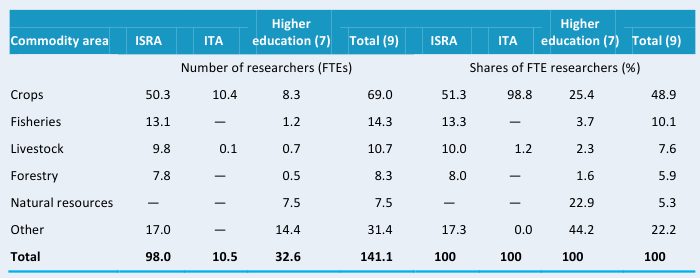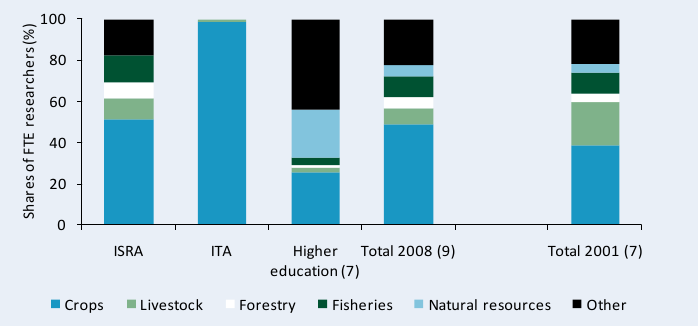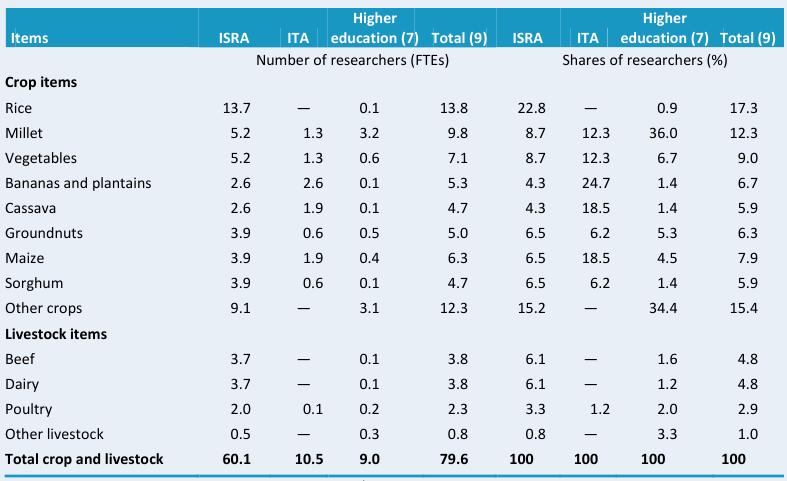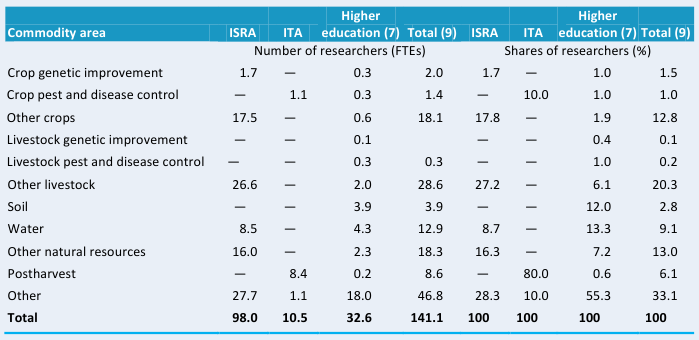ASTI Data in Focus” provides additional facts, figures, and tables in support of the 2010 Country Note on Senegal (asti.cgiar.org/pdf/Senegal-Note.pdf) prepared by the Agricultural Science and Technology Indicators (ASTI) initiative and the Senegalese Agricultural Research Institute (ISRA)..
Using data collected by ASTI and ISRA, the Country Note and the “ASTI Data in Focus” series review major investment and capacity trends in Senegalese public agricultural research and development (R&D) since 1976. These outputs provide important updates on agricultural R&D trends prepared by ASTI and ISRA during 2000–03.
D. Research Allocation across Commodities and Themes
This section provides detailed quantitative information on Senegalese public agricultural research allocation for 2008. Complementary sections of this series on Senegal present detailed data on long-term trends (Section A), financial resources (Section B), and human resources (Section C). Further supporting information provides macroeconomic trends, a list of agencies included in the study, data sources and estimation procedures, and ASTI’s methodology.
Table D1—Research focus by major commodity area, 2008
This table presents the number of researchers employed at ISRA, ITA, and in the higher education sector by major commodity area both in absolute terms (as full-time equivalents [FTEs]) and in relative terms (as shares). Of the total 141 FTE researchers identified as working in agriculture in 2008, 69 (or nearly half the researchers) were focused on crop research, 14 were focused on fisheries, 11 on livestock, 8 on forestry, 8 on natural resources, and 31 on other commodity areas.

Sources: Calculated by authors from IFPRI–ISRA 2008/09 and Stads and Senè 2004.
Notes:
Figures in parentheses indicate the number of agencies in each category. Data exclude expatriate
staff employed at ISRA.
Figure D1—Research focus by major commodity area, 2008
This figure presents the allocation of FTE researchers across the major commodity areas (see also Table B1). In 2008, close to half of Senegal’s 141 FTE researchers in agriculture were involved in crop research. Fisheries research accounted for 10 percent, livestock research for 8 percent, forestry research for 6 percent, and natural resources research for 5 percent. The remaining researchers concentrated their efforts on other matters. Notably, a quarter of Senegal’s agricultural researchers conducted livestock
research in 2001 compared with just 7 percent in 2008. The Senegalese Agricultural Research Institute (ISRA) is largely responsible for this shift, given that it employed 26 FTEs focusing on livestock in 2001 and only 10 in 2008.

Sources: Calculated by authors from IFPRI–ISRA 2008/09 and Stads and Senè 2004.
Notes: Figures in parentheses indicate the number of agencies in each category. 2001 data are shown for the purpose of comparison and exclude two small units under the University Gaston Berger. Data exclude expatriate staff employed at ISRA.
Table D2—Focus of crop and livestock research by major item, 2008
The most researched crops in Senegal in 2008 were rice and millet, employing 14 and 10 FTE researchers and representing 17 and 12 percent of total crop and livestock research combined, respectively. Other important crops included vegetables, maize, cotton, bananas and plantains, groundnuts, cassava, and sorghum. The Senegalese government overtly prioritizes research on food crops over export crops due to the importance of food security. The country’s livestock researchers concentrated primarily on beef (5 percent), dairy (5 percent), and poultry (3 percent).

Sources: Calculated by authors from IFPRI–ISRA 2008/09.
Note: Figures in parentheses indicate the number of agencies in each category. Data exclude expatriate staff employed at ISRA.
Table D3— Focus of crop and livestock research by major theme, 2008
This table presents FTE researchers by thematic area in absolute and relative terms. Natural resources are an important research theme in Senegal accounting for 39 of the 141 FTE researchers in 2008. That year, 9 percent of Senegal’s agricultural researchers focused on water, 3 percent focused on soil, and 13 percent focused on other research related to natural resources. Postharvest research was another important area accounting for 6 percent of the country’s agricultural researchers. Large variations were reported across agencies; 80 percent of researchers at the Food Technology Institute (ITA), for example, focused on postharvest research, whereas few of the researchers at the other agencies worked in this area.

Sources: Calculated by authors from IFPRI–ISRA 2008/09 and Stads
and Senè 2004.
Notes: Figures in parentheses indicate the number of
agencies in each. Data exclude expatriate staff employed at ISRA.
